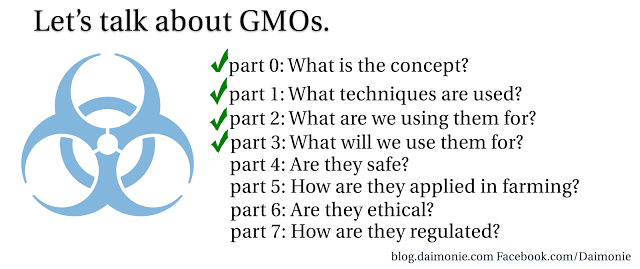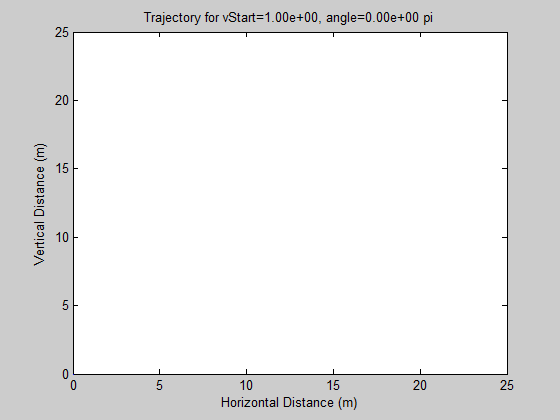Let's talk about GMOs, part three: What will we use them for?
Introduction
In my first post, I discussed what DNA is and how it relates to phenotypical (outward) change through the central dogma of molecular biology. In the second post I discussed the techniques of genetic engineering, including the novel and prodigal technique called Crispr/Cas9. In the third and previous post we discussed current uses of the technology.
In this post, we will look at the future uses of the technology. I can not promise to cover all possible future and research purposes, simply because it is too extensive. I will discuss three good examples, one for research, one for medicine and one for food. We will leave the issue of designer babies for the next part in the series.
Wide-field Fluorescence microscopy
 |
| Frames from two-colour video microscopy showing single-molecules diffusing and binding inside E-coli.[Royal Society Publishing] |
Wide-field fluorescence microscopy is a research technique to investigate how things work on a microscopic scale. We'll need a short discussion on how the microscopy part works. Fluorophores are molecules that can be activated by (laser) light, after which they will emit light either spontaneously or when probed by laser light again. A trait for fluorescence, the Green Fluorescent Protein gene was found in jellyfish. It allows an organism to make green fluorescent proteins. The gene can easily be incorporated into model organisms but more importantly, incorporated into existing proteins. The code for a particular protein might look like "Start", "Protein", "Stop". You can turn this into "Start", "Protein", "Linker", "GFP", "Stop" and have the same protein but fluorescent. The linker is a sort of string; you are effectively tagging a fluorescent balloon onto the protein. If the Linker, the string, is sufficiently long then the fluorescent GFP protein part will not interfere with its function. This is something that you need to verify as a step in your research.
By now, many variations exist that allow for different colours, e.g. Yellow FP, Red FP, Cyan FP, etc. Let us not focus on the colour and call it XFP for now (X being the colour). XFP genes can be combined with an antibody, something that recognises and attaches something else, to 'dye' or 'mark' whatever it is the antibody attaches to.
By now, many variations exist that allow for different colours, e.g. Yellow FP, Red FP, Cyan FP, etc. Let us not focus on the colour and call it XFP for now (X being the colour). XFP genes can be combined with an antibody, something that recognises and attaches something else, to 'dye' or 'mark' whatever it is the antibody attaches to.
In single-molecule studies some proteins (single molecules) are marked by these fluorescent proteins and their location can be tracked. It's quite a complicated process to make a GM bacteria with these properties, but we have discussed the techniques previously. In single-molecule studies, the goal is then often to see what proteins work together. You could for instance imagine seeing proteins inside a cell at random positions when they don't do anything. However, when they have to work together they suddenly focus in one position and differently coloured proteins are in the same place (co-localisation). In the image to the right, you see an example of such an experiment.
As an example of such research. During DNA replication the replication machine (replisome) can encounter all sorts of blockades. One such barrier is Tus-ter, which is a protein (TUS) bound to a specific sequence (TER region). Fluorescent microscopy has shown that the replisome remains bound to the DNA when it encounters this blockade and that it will eventually move on. In essence, it encounters a red traffic sign. [Nucleic Acids Research]
As an example of such research. During DNA replication the replication machine (replisome) can encounter all sorts of blockades. One such barrier is Tus-ter, which is a protein (TUS) bound to a specific sequence (TER region). Fluorescent microscopy has shown that the replisome remains bound to the DNA when it encounters this blockade and that it will eventually move on. In essence, it encounters a red traffic sign. [Nucleic Acids Research]
Gene Therapy
 |
| Diseases and human chromosomes mapped out. Not at all the complete list [wiki]. |
There are diseases that literally run in the family. On the right, a diagram relating diseases to chromosome number is shown, but it is not at all a complete overview. There are some 4000 known diseases caused by single-gene defects. There are many, many more that are caused by multiple-gene defects. The latter are perhaps less deterministic - diabetes in the family, for instance, makes you more likely to carry the genes for it. On the other hand, a disease like Huntington's is a 50% chance.
Huntington's is the disease that made me think about the ethics of human gene editing in the first place. The disease was mentioned in "House, MD". It is an inherited disorder resulting in the death of brain cells. Beyond a progressive lack of coordination, mental abilities ultimately decline into dementia. Symptoms usually start between 30 and 50 years of age, but can start at any age. Take that in for a minute. If you find out that you have this disease, then your children have almost 50% chance of having it. And at age 30-50, that's the most likely situation. If that could be solved by screening and an injection of a CrispR/Cas9 like tool that removes the faulty gene and turns it back into the correct version? That can prevent the gene from passing on to your progeny? That would be amazing.
We're not there yet. But that is the future: Gene therapy. Using genetic engineering methods in medicine. This can be a global DNA change, although that would be hard. But you could also include, say, two traits: One that counters a defective protein and one that makes the correct one. In that case, you would be able to counter something like Huntington's without changing all DNA.
Despite some promising research projects in this direction, gene therapy isn't there yet. I don't know how long it will take, but a discovery like CrispR/Cas9 is significant in that regard.
Crop traits
Previously, I mentioned Golden Rice: Rice that is genetically engineered to contain pro-vitamin A. Vitamin A deficiency compromises the immune systems of approximately 40% of children under five in the developing world, being most severe in Southeast Asia and Africa [goldenrice]. I also mentioned the June 2016 letter from 123 Nobel laureates to Greenpeace, the UN and the governments around the world. They specifically asks to cease and desist resistance to golden rice. In conversations, I have heard people mention: "Why don't we just introduce them to carrots?". Yes, my friends, let them eat cake.
 |
| Green super rice test field. |
Golden Rice is an example of a GE trait that can serve us in the future. There are many such possible traits, traits that can fight malnutrition and famine in general. Consider incorporating drought-resistance into common crops of third-world countries. This is a trait for the future, even though you might have heard mention of it before. The complex mechanisms underlying drought resistance still need elucidation, but there is progress. An example of this is Green Super Rice, "Rice bred to perform well in the toughest conditions where the poorest farmers grow rice" led by the Chinese Academy of Agricultural Sciences and the International Rice Research Institute.
 |
| Adopted from Hu and Xiong, Annual review of plant biology. Reproduced without permission. |
Drought resistance is clearly a very complex issue. In Annual Review of Plant Biology, Honghong Hu and Lizhong Xiong include the schematic on the right for dissecting the mechanisms of drought-resistance and improving drought-resistance in crops. They include approaches that are classical (blue) and reverse (purple) to study the genetic and molecular basis of drought-resistance and to identify genetic information for engineering and breeding drought-resistance crops.
The first type of current commercial crops have the trait of being resistant to a pesticide. Counter-intuitively this has led to a decrease in applied pesticides. I have mentioned this before in some more detail, but the idea is that a larger single application leads to a smaller number of applications over a growth season, thus decreasing the overall use. The second type of current GE crop deal with pests themselves. Bt crops are engineered to produce a protein naturally found in Bacillus thuringiensis (Bt), specifically a crystal protein that is toxic to many pest insects. These crops thus only target the actual pests, as they can only target the pests that are affecting them. Clearly, the less novel direction of development is future incorporation of resistance traits and traits similar to Bt crops, where a protein or even multiple proteins are incorporated to fight pests.
Overall, it must be pointed out that one reason climate change is so detrimental is that natural evolution often can't outpace the changing climate. Having a tool to induce direct change into our crops will help us develop agriculture that is future/climate-change proof and is not limited to the wealthy. Naturally, we must keep a careful eye on the safety and economics of each of the different varieties developed this way, but systems are already in place for this purpose.
Conclusion
In this post, we've discussed a genetic engineering use for the future (research) and one for the future (medicine). The first is a way of figuring out how biological processes work. The second is a way of how we can use genetic engineering to cure some of diseases and disorders that plague the human species. As a third topic, we discussed future GE crop traits.
We didn't discuss how GE is used to manufacture medicine now and how that might evolve in the future. We didn't discuss VLPs, a non-infectious agent that can be used to vaccinate even more safely.
In the next post, we will turn to safety. Are GE crops safe? What about research techniques, is there any chance of killer-chickens?



